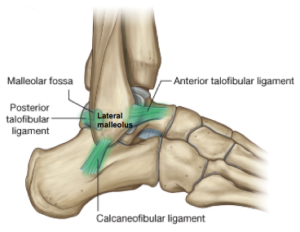It happened several weeks ago as you stepped off the curb. Your doctor told you that you sprained your ankle. What is an ankle sprain? What are the different types of ankle sprains? How can I tell if I have an ankle sprain? How long does a sprained ankle stay swollen? Let’s dig in.
What Is an Ankle Sprain?
An ankle sprain is one of the most common musculoskeletal injuries. The incidence is 2.15 per 1000 person-years in the United States (1). There is a higher incidence of ankle sprains in females compared to males, children compared to adolescents, and adolescents compared to adults (2) The injury occurs when one or more of the ligaments in the ankle are stretched or torn. The most common ankle sprain involves the ligaments on the outside of the ankle (3). The outside of the ankle is also referred to as lateral. Said another way, lateral ankle ligament injuries are the most common. There are three principal ligaments on the outside of the ankle.
- ATF: Anterior Talo-Fibular Ligament
- PTF: Posterior Talo-Fibular Ligament
- CF: Calcaneal Fibular Ligament
The names of the ligaments reflect the two bones that the ligament stretches across. For example, the CF ligament connects the calcaneus (heel bone) and fibula (smallest of the two calf bones).
Different Types of Ankle Sprains?
Ligaments are thick pieces of connective tissue that connect bone to bone. Ligaments provide important stability for the ankle. Ligaments can be overstretched or torn. These injuries are called sprains. There are three types of ankle sprains (4)
Grade 1 Sprain
A Grade 1 sprain involves the least amount of ligament injury. Ligaments are typically overstretched without tearing. Symptoms involve mild swelling and tenderness with no functional loss or instability (5). Go our blog, “How to Treat Ankle Sprains,” to learn more.
Grade 2 Sprain
These sprains are more severe than Grade 1. Ligaments are partially torn. Symptoms include moderate pain, swelling, tenderness, restricted range of motion, and joint instability. Read: “Sprained Ankle: When Do You Need Surgery?” for more information.
Grade 3 Sprain
This is the most severe injury and involves a complete tear of the ligament. Symptoms include marked swelling, bruising, and tenderness. There is severe loss of function with most patient’s being unable to bear weight. The ankle joint in a Grade 3 sprain is misaligned and unstable.
How Can I tell if I have an Ankle Sprain?
You may have sprained your ankle if you notice ankle swelling, tenderness, bruising, or difficulty putting weight on your ankle. If any of these symptoms persist an evaluation is indicated. Bypass the surgeon as they are trained to provide surgical solutions. These solutions are not always in your best interest. A physician trained in Interventional Orthopedics is best suited to provide you with nonsurgical treatment options. X-ray of the foot/ankle is important to rule out fractures. The integrity of the ankle ligaments can be evaluated using different physical examination tests. Two common tests include the Anterior Draw test and the Talar test. At the Centeno Schultz Clinic, ankle ligaments are evaluated both by physical examination and ultrasound testing. The ligaments are evaluated with ultrasound both under static and dynamic conditions. The latter is called a stress ultrasound. To learn more about the importance of stress ultrasound please click on the video below.
So – How Long, Again?
An ankle sprain is a significant injury. How long it stays swollen depends upon the severity of the injury. Recovery is dependent upon multiple factors including the grade of sprain, past medical history, current medications, bracing, and return to weight-bearing (6). A Grade 3 sprain requires surgery. If you have sprained your ankle and despite conservative therapy are still having swelling and pain this is an important warning sign. Persistent swelling is an indication that there is underlying irritation and joint dysfunction. Most likely your continued ankle swelling is due to joint instability.
Stability is a key concept. Stable in a mechanical sense means resistance to falling apart or falling down. Stable in terms of a joint means that the surfaces of the joint are kept in good alignment as we move. Why is this important? When the joint surfaces collide with one another and are not able to be kept in good alignment while we move, the joint wears down much faster. That means that the cartilage, tendons, and muscles experience many times more wear and tear than a stable joint.
So your persistent ankle swelling after an ankle sprain is a warning sign. If left untreated patients can develop chronic lateral ankle instability. Approximately 10-30% of patients with lateral sprains develop chronic ankle instability (10). This puts your ankle, its cartilage, and supporting structures at risk for additional damage including arthritis.
Treatment Options for Ankle Sprains
At the Centeno-Schultz Clinic, treatment options for ankle injuries include PRP and stem cells. PRP is rich in growth factors that can improve blood flow and accelerated healing. There are three important phases of ligament healing which include acute inflammation, proliferative, and tissue remodeling. Each phase occurs over different time periods. To learn more about how ligaments respond to PRP and stem cell injections, please click on the video below.
How long does a sprained ankle stay swollen? – In Conclusion
An ankle sprain is one of the most common musculoskeletal injuries. It involves a stretched or torn ligament. Ligaments are thick pieces of connective tissue that connect one bone to another. The most common ankle sprain involves the ligaments on the outside of the ankle. There are three types of ankle sprains: Grade 1, 2, and 3. The severity of the injury and associated symptoms increases from Grade1 to Grade 3. Ankle swelling, tenderness and difficulty walking on the ankle are all symptoms suggestive of an ankle sprain. There are specific manual tests to determine the integrity of your ankle ligaments. At the Centeno-Schultz Clinic, ultrasound is used in the evaluation of all ankle injuries. A stress ultrasound is an important tool in assessing the health of a ligament. How long a sprained ankle stays swollen is dependent upon the severity of the injury. Persistent swelling is a warning sign that there is an underlying problem. The most common cause of persistent swelling is instability of the ankle joint due to laxity or injury to the supporting ligaments. If left untreated patients are at risk for developing ankle arthritis and additional injury to tendons, muscles, and ligaments.
If you or a loved one continues to have swelling after an ankle sprain know that the swelling is a warning sign! If left untreated things can be much worse leaving you with fewer treatment options. Schedule a Telemedicine consult with a board-certified physician who can review your history, studies, and provide you the best nonsurgical treatment option. Listen to your body as it is warning you!
References
1.Waterman BR, Belmont PJ Jr, Cameron KL, Deberardino TM, Owens BD. Epidemiology of ankle sprain at the United States Military Academy. Am J Sports Med. 2010;38(4):797-803. doi:10.1177/0363546509350757
2.Doherty C, Delahunt E, Caulfield B, Hertel J, Ryan J, Bleakley C. The incidence and prevalence of ankle sprain injury: a systematic review and meta-analysis of prospective epidemiological studies. Sports Med. 2014;44(1):123-140. doi:10.1007/s40279-013-0102-5
3. Giannini, S, Ruffilli, A, Pagliazzi, G. Treatment algorithm for chronic lateral ankle instability. Muscles Ligaments Tendons J. 2014;4(4):455–460.
4.Balduini FC, Vegso JJ, Torg JS, Torg E. Management and rehabilitation of ligamentous injuries to the ankle. Sports Med. 1987;4(5):364-380. doi:10.2165/00007256-198704050-00004
5. Polzer H, Kanz KG, Prall WC, et al. Diagnosis and treatment of acute ankle injuries: development of an evidence-based algorithm. Orthop Rev (Pavia). 2012;4(1):e5. doi:10.4081/or.2012.e5
6.Kerkhoffs GM, Rowe BH, Assendelft WJ, Kelly KD, Struijs PA, van Dijk CN. Immobilisation for acute ankle sprain. A systematic review. Arch Orthop Trauma Surg. 2001;121(8):462-471. doi:10.1007/s004020100283
7. Renstrom, PA, Lynch, SA. Ankle ligament injuries. Revista Brasileira de Medicina do Esporte 1998;4(3):71–80.


